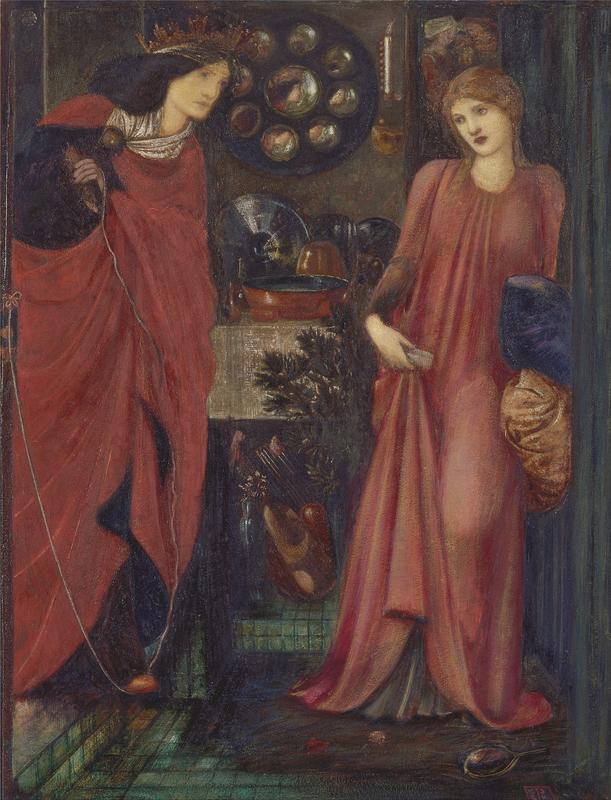More about Fair Rosamund and Queen Eleanor

Sr. Contributor
Would it shock you to hear that a powerful strong woman was reduced to a murdering spurned wife in folklore? No?
Just like how all the scheming temptresses or nagging wives of myth often have far more nuance than their writers cared to share, Eleanor of Aquitaine was done dirty for centuries.
There’s a lot that can be said about Queen Eleanor. She was a queen twice over, once of France then of England. She exerted a great deal of influence and could arguably be called the “Grandmother of Europe” with how many of her children took on powerful positions.
But let’s put a hold on history for now and speak of her caricature: the “hell hath no fury” version of her that is steeped in no fact whatsoever. Our artist, Edward Burne-Jones, had a particular interest in the story of Fair Rosamund, as many artists and writers of the Pre-Raphaelite movement did. He chose to paint the moment depicted here, of Queen Eleanor discovering Rosamund, in two different works of art. His interest in Rosamund extended so far that he even visited her grave.
In the romantic folklore, you’ve got your basic set-up. King in an unhappy marriage, falls in love with a beautiful innocent girl and tries to protect her from his wife, who becomes the villain by default since we’re supposed to side with the cheating man in power. Then things take a step in a weird direction. The king, Henry II of England, puts Rosamund up in a lavish home that doubles as a labyrinth to protect her. Of course he knows how to get past it for them to enjoy their “love” but no one else is supposed to be able to.
Enter Queen Eleanor, who takes a page from Ariadne’s playbook and uses thread to make her way successfully through the labyrinth. In our artist’s other painting of the scene, Eleanor also uses the thread to trap Rosamund and prevent her escape. But while that doesn't happen in this version of the confrontation, you can still see the thread draped around Eleanor as she looms over the shrinking Rosamund. What happens next is Eleanor poisons Rosamund and oh no, true love is thwarted.
When the story got popular, the later versions doubled down on making it more brutal to sell more copies. They describe Eleanor stabbing her, burning her, and leaving her to die in a scalding hot bathtub.
As for Rosamund herself, not much is really known about her sadly. Beyond being beautiful and Henry II’s mistress, most other details about her are up for debate. Some say she entered a nunnery but there’s only proof that she was buried at one. Her actual cause of death is unknown.
As for Queen Eleanor, she was actually imprisoned at the time of Rosamund’s death so there’s no doubt the murderous encounter was complete fiction. Henry II imprisoned her until his death because she supported her sons in a revolt against him, one that failed.
Freed and now short one adulterous husband, Queen Eleanor took on more power and influence than ever before. Among her several children was one Richard the Lionheart, whom you might know as the literal lion from Disney’s Robin Hood or as “Good King Richard.”
Considering Richard was king for some ten years but spent less than a year actually in England (he was a big fan of fighting in Crusades) whether that title is fitting is… arguable. But it is an example of how far Queen Eleanor’s influence extended as that particular piece of enduring propaganda was part of a campaign she headed. The campaign was to raise money from the people of England to pay Richard’s ransom (he was captured while en route home from a Crusade) and have him returned. The citizens of England raised enough and got him back for all of a month before he ran off on another Crusade.
In his absence, before and after ransom, Eleanor helped keep the kingdom intact acting as administrator of the realm. So really it was “Good Queen Eleanor” the people had to thank for their prosperity while her son played at war.
Sources
- "'Fair Rosamund and Queen Eleanor', Sir Edward Coley Burne-Jones, Bt, 1862." Tate. August 2004. Accessed January 17, 2022. https://www.tate.org.uk/art/artworks/burne-jones -fair-rosamund-and-queen-eleanor-n03822
- "Eleanor of Aquitaine." Encyclopædia Britannica. Accessed January 17, 2022. https://www.britannica.com/biography/Eleanor-of-Aquitaine.
- Evans, Michael R. Inventing Eleanor: The Medieval and Post-medieval Image of Eleanor of Aquitaine. London: Bloomsbury, 2016.
- Ilse, Jess. "Royal History Mystery: Did a Queen Murder Her Love Rival?" Royal Central. May 28, 2020. Accessed January 17, 2022. https://royalcentral.co.uk/features/royal-history -mystery-what-happened-to-the-fair-rosamund-143213/
- "Imprisonment of Richard I." Encyclopædia Britannica. Accessed January 17, 2022. https://www.britannica.com/biography/Richard-I-king-of-England/Imprison….
- "Queen Eleanor and the Fair Rosamund." The De Morgan Foundation. August 27, 2019. Accessed January 17, 2022. https://www.demorgan.org.uk/collection/queen -eleanor-and-the-fair-rosamund/.
- "Richard the Lionheart May Not Have Spoken English – plus 7 More Surprising Facts." HistoryExtra. April 8, 2020. Accessed January 17, 2022. https://www.historyextra.com/ period/medieval/8-things-you-probably-didnt-know-about-richard-the-lionheart/.
- "Rosamond." Encyclopædia Britannica. Accessed January 17, 2022. https://www.britannica.com /biography/Rosamond-English-mistress.











